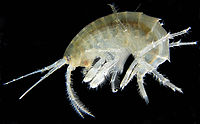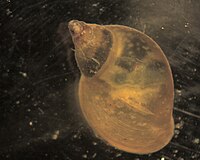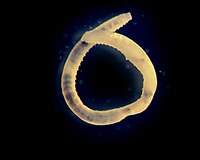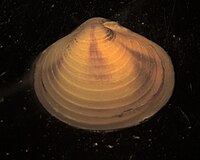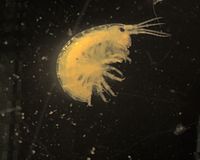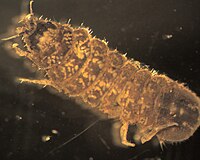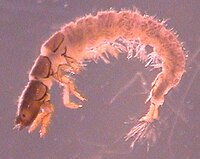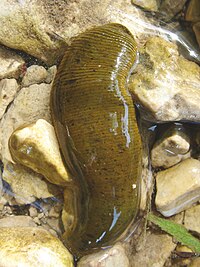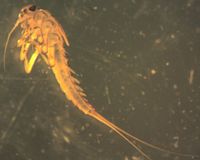Troublesome Brook
From WikiEducator
| Stream code: | BRX_TrbBrk_99 |
| Basin: | Bronx River |
| State or Province: | New York |
| Country: | USA |
| Latitude: | 40.957167 |
| Longitude: | -73.827667 |
| School: | DeWitt Clinton High School |
The following are the most common invertebrates collected from this stream site.
Contents
Gammaridae
The body of this scud is flattened side-to-side. It has seven pairs of walking legs and two pairs of antennae. On third third antennal segment, there is a segmented flagellum.
Images of the body flattened side-to-side, and the segmented flagellum.
Lymnaeidae
Members of the family Lymnaeidae belong in the class of Gastropoda. Members contain a single, coiled shell with a right-handed spiral. Differing from those of Planorbidae, members of Lymnaeidae have a larger opening. Respiration in these snails are through lung-like structures. Preferred habitats include those with slow streaming waters and heavy vegetation. These right handed snails are somewhat less tolerant of water pollution than our other common snails.
Images of the family Lymnaeidae and the class Gastropoda.
Oligochaeta
Aquatic earthworms lack legs and are characterized by having 20 or more segments. Unlike leeches, they lack a suction disk. We collect members of two or more orders in this class as small numbers of stream sites and they are rarely numerous. They are more common at pond and lake sites.
Image of the 20 or more segments.
Corbiculidae
On this shell, the hinge ligament is visible from the outside as a leathery bulge. On the inside, three cardinal teeth are visible, and on either side of those, there are two rows of lateral teeth. Corbiculids, also called Asian clams, are invasive and not currently found in Vermont waters, although they have been found just two locks below Lake Champlain. We have seen them in samples from Puerto Rico and The Bronx NY. .
Images of the hinge ligament, and the teeth.
For more information on preventing exotic introductions, visit VT DEC's Aquatic Invasive Species site
Hyalellidae
The body of this scud is flattened side-to-side. It has seven pairs of walking legs and two pairs of antennae. The first pair of antennae is shorter than the second pair in members of this family.
Asellidae
These aquatic sow-bugs have seven pairs of legs and a dorso-ventrally flattened body. They have two pairs of antennae; one pair is much longer than the other pair.
Images of the body and the two pairs of antennae.
Chironomidae
Midge larvae tend to be the most common macroinvertebrate at our sites. As with other Diptera, there are no true jointed legs. Chironomidae do have a pair of prolegs at each end and preserved individuals tend to curl into a 'C'. Identification past family requires slide-mounted heads. We have seen philopotamid caddisflies misidentified with the chironomids and we suspect that that happens when samples are being sorted from trays. Under a microscope, six prominent legs can be seen on members of the caddisfly family Philopotamidae.
More information on Philopotamidae.
Cheumatopsyche
Cheumatopsyche has a forked foretrochantin (as does Ceratopsyche). The foretrochantin is the projection at the uppermost portion of the front leg closest to the head. The leg may need to be pulled away from the body to expose this feature. Cheumatopsyche have a small or inconspicuous pair of sclerites under the prosternal plate that are difficult to see. Contrast that with the larger pair of sclerites found on Ceratopsyche. To access sclerites, it's best to gently pull the pronotum and mesonotum in opposite directions. Note: the large single sclerite is the prosternal plate. Cheumatopsyche have only 2 types of hair on the abdomen: long thin plain hairs and thicker club hairs, which are narrow close to the body and widen out at the distal end. Paired sclerites on the ninth abdominal segment are notched.
Hirudinea
Leeches have bodies with 20 or more segments and a ventral suction disk on at least one end, though sometimes on both ends. They are segmented worms (Phylum Annelida) in the Class Hirudinea. Most of the leeches we sample come from ponds and lakes but they are also commonly found in streams.
Image of the ventral suction disk.
Baetidae
This mayfly has either two or three cerci ("tails") and a unique head shape. Its gills are oval shaped and insert dorsally. Commonly encountered genera include Acerpenna, Baetis and Pseudocloeon.
More information on the genera:

